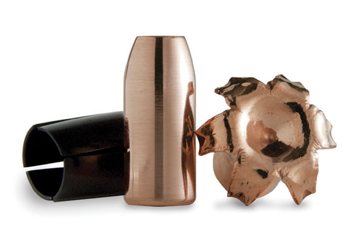Reloading: Putting the Boot in!
- By Pete Moore
-
20
 Comments
Comments
- Last updated: 18/11/2016

According to the Oxford English Dictionary, sabot (sah-boh) is an early 17th Century word meaning a wooden shoe or boot. So what the hell is that all about? The origins of its use in conjunction with a projectile are not entirely clear. It seems that it may have started as a shaped wooden ‘pusher’ block behind a cannon ball… In modern ordnance the sabot is primarily designed as an obturator to impart drive and (usually) spin to a projectile that is of a diameter smaller than that of the bore of the barrel.
FORM AND FUNCTION
There are now no less than five identifiable types of sabot, of which only the first three are really relevant to our purpose:-
HOW AND WHY
Modern sabot use in small arms covers a number of gun types. Muzzle-loading hunters in the US use them and they do up the effect of a slow and primitive system. In some ways a plastic plus wad for a shotgun could be considered to do the same job. Still with smoothbores there are also a number of sabot slug loads, which are highly effective.
In rifled firearms they can extend the range of performance that can be obtained from a given rifle/calibre combination. It is obvious that a sabot can only be used in conjunction with a projectile that is smaller than the bore, but by how much? The difference has to allow for the wall thickness of the sabot body. If we take 1mm (0.040”) as a reasonable minimum and the smallest commercially available jacketed bullet as .224” then we more or less get the most popular calibre around .308”.
If the pill is smaller and lighter then the benefit will be velocity – lots of it. That means that a .30” calibre based rifle can potentially make use of a flat shooting small pest/ varmint round with devastating performance.
ASSEMBLY ISSUES
Sounds easy, buy some sabots, stuff them with a .224 pill, ram the case full of powder, seat the projectile and get shooting. Not so fast! The choice is limited, only two American makers come to mind and their products are almost identical. Choice of bullets appears large but certain considerations apply. It should not be a boat-tail (unless the sabot is suitably shaped) as the base of the sabot will be dangerously deformed during firing. Open HP bullets may disrupt due to partial loss of structural integrity in the highest velocity designs. Copper-washed or thin jacket designs should never be used. Solids and pointed soft points are ideal. Propellant charge and type should be based upon the recommendations of the manufacturer. In general they will involve a generous helping of one of the faster powders listed for the cartridge, such as H322 in 308 Win.
Bullet prep should include a mild detergent wash and dry to remove any manufacturing polishing residues. Seating the bullet in the sabot is a simple push fit, but putting it into the case neck is slightly more complex. Always lightly de-burr the inside neck rim to avoid marring the sabot. Use the dedicated seating tool supplied by the maker, it will hold the assembly in the correct position, avoid damage and accurately centralise the bullet. Calculate the seating depth in the usual way. Ensure good neck tension without the use of a crimp… indeed, mega-consistent neck tension is the key to consistent performance. Work up a load as you would with a regular bullet. There are velocity claims of over 4800 fps in .308 Win/.224, but figures of around 4500 fps seem more credible.
MAKE OR BRAKE
Never fire saboted rounds in a rifle fitted with a muzzle brake or moderator. There is a serious risk that the sabot will open into the vents or ports and disrupt. The results can be extremely dangerous. Be very careful in building saboted ammo for use in super tight twist barrels as extreme rotational speeds can cause increases in forcement and even projectile disruption. Bore cleaning should not require special materials or techniques, Hoppes seems to eat or dislodge the small amounts of polymer residue.
Accuracy/shot grouping of such rounds has always been the hot issue. Whilst there is little chance of this recipe becoming a Benchrest classic, the well developed saboted round can offer more or less guaranteed fox killing at 100yds.
Commercially loaded saboted ammunition is currently offered by a few specialist American makers. Of the big name brands only Remington offered such a product. They marketed a .30-06 Accelerator cartridge with a .224”, 55gn Pointed SP and a claimed 4080 fps together with a .30-30 Win Accelerator cartridge employing the same pill and giving 3400 fps.
ALLO ‘ALLO, WHAT SIZE IS THIS BOOLIT?
Apocryphal tales abound of police objections to the construction and use of saboted rounds. The Firearms Act 1968 (as amended) only refers to sabot discarding ammo designed to be armour piercing as Section 5 and that’s another ball game. The most popular myth is that a sabot launched bullet is unacceptable because it will be devoid of rifling marks and therefore untraceable. So what?
Where the sabot reloader MUST be wary is in respect of authority to possess expanding bullets. Once loaded into a .308 case, if that is what you have on your ticket, a sabot with a centrally positioned core projectile of a smaller size would pose no problem since the projectile is of the correct calibre until it exits the muzzle. However, the purchase and holding of the unassembled ‘smaller’ bullets of another calibre could require additional authority. The get-out is the simple fact that a suitable, ‘non-expanding’, TARGET bullet travelling at 4000 fps will most certainly get the job safely done. Indeed, it highlights the crassness of our government in rigidly classifying all inert BULLETS as either expanding or non- expanding. It’s in the ballistics, stupid!
